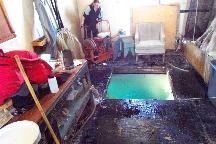
Our work here involves continuous lab time, and
we need a steady
supply of fresh pteropods for these experiments. Using
an 18 inch diameter
plankton net, scanning maybe 130 linear feet or about
5-6 cubic meters of
water, we have been lucky to get one pteropod on average.
It is still early in the
season. Although abundant blooms are expected in January
little is known
about how and when to catch these beasts in significant
numbers in the early summer. Up until the
last few days we have been keeping up with needs by twice
daily jaunts to hut 4,
a short walk from the lab out onto the sea ice,
where the water depth is about 65 feet.
(One healthy animal can give us a 4-5 hour experimental
run.) Out technique is to
scan downward to the bottom, using a weight attached
to a bridle, let the weight
hit the bottom so as to stir up activity, then haul back
up for a second scan.
We have however been plagued by snagging nets. The weight
gets caught in cracks
in the bottom rock (the bottom is the same volcanic basalt,
very craggy), and we have to call
in divers to retrieve the net. This means a day's delay.
This happened three times, and led
to a pteropod crisis which threatened to halt experimentation.
Fortunately Teri McLain, who operates two large plankton
nets down to 350 meters out of hut 3,
offered once again to take us along to haul up her nets
and see what pteropodal component there
might be in her zooplankton. We were rewarded with an
extraordinary catch of 60-70 healthy
specimens. Now back to the lab!
Teri at the winch, hauling up the nets:
What have we here?
Robert Dudley and Teri McLain:
Robert, Teri, and myself:
I happen to catch a Skua in flight, one of the few flying birds I have seen here:
Headed home: